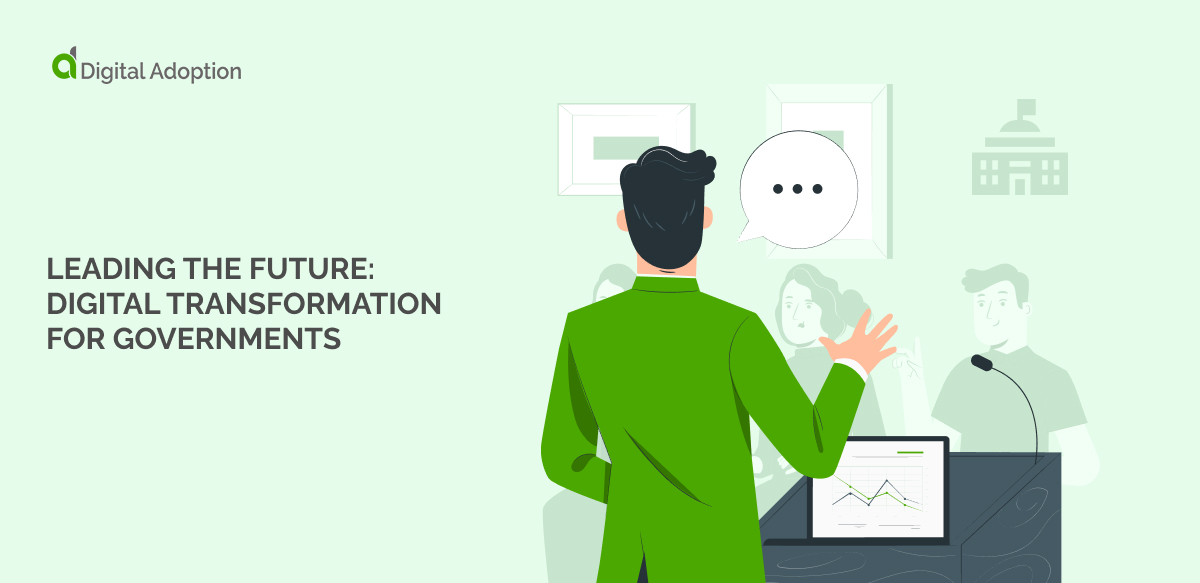In an era where technology has become integral to our daily experiences, government services must adapt and evolve alongside these advancements.
Historically perceived as slow and disjointed, government institutions now have the opportunity to redefine themselves by embracing digital transformation (DX) and the subsequent digital transformation of innovative solutions.
In a global survey conducted by Deloitte, government officials revealed the significant impact of digital technologies on governance. A substantial 75% of respondents acknowledged that digital technologies are disrupting the public sector, with an overwhelming 96% describing the influence on their respective domains as substantial.
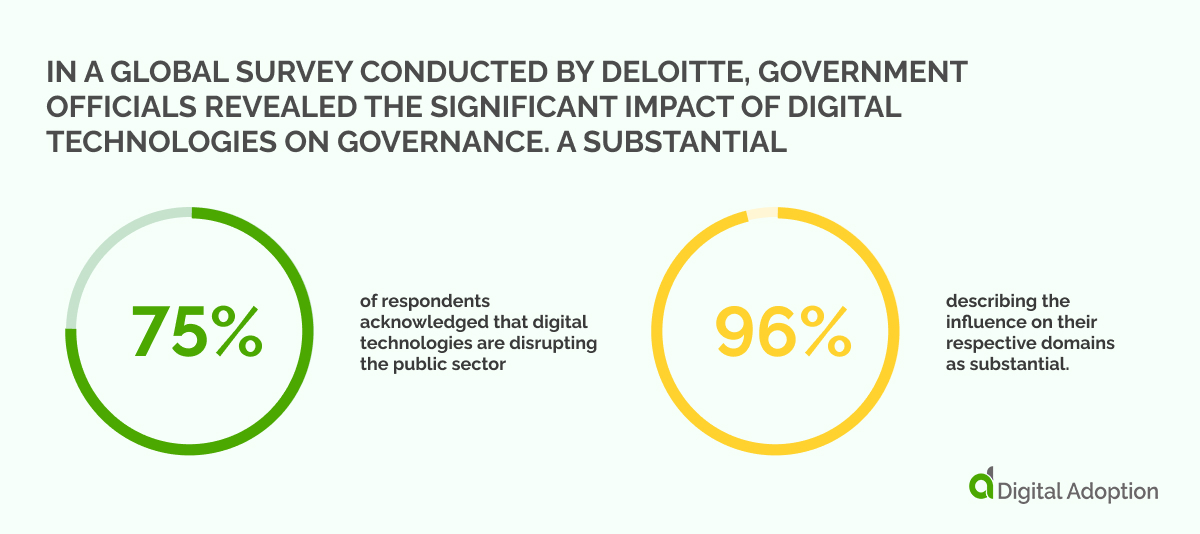
The survey further highlighted the varying stages of digital transformation across governments worldwide. While a small percentage of these institutions can be considered “maturing” in their digital transformation journey, the majority remain in the initial or developing phases, emphasizing the diverse progressions of digital transformation in the public sector.
This article delves into the world of digital transformation for governments and presents a comprehensive transformation guide. We begin by exploring the concept of digital transformation in the context of government agencies, followed by an insightful analysis of the essential drivers propelling the digital transformation of public services.
We then examine the numerous benefits that digital transformation brings to governments and the obstacles that may hinder the digitalization of government services. Through real-life case studies, we demonstrate the remarkable impact of digital transformation in various governments around the globe.
We’ll also outline a strategic roadmap to pave the way for government digital excellence in 2023, empowering public institutions to embrace innovation and deliver exceptional service to their citizens.
- What is digital transformation in government?
- Essential drivers of government digital transformation
- Benefits of digital transformation for government
- Obstacles in Digitalizing Government Services
- Real-life Cases of Digital transformation in Governments
- Paving the way for government digital excellence in 2023
What is digital transformation in government?
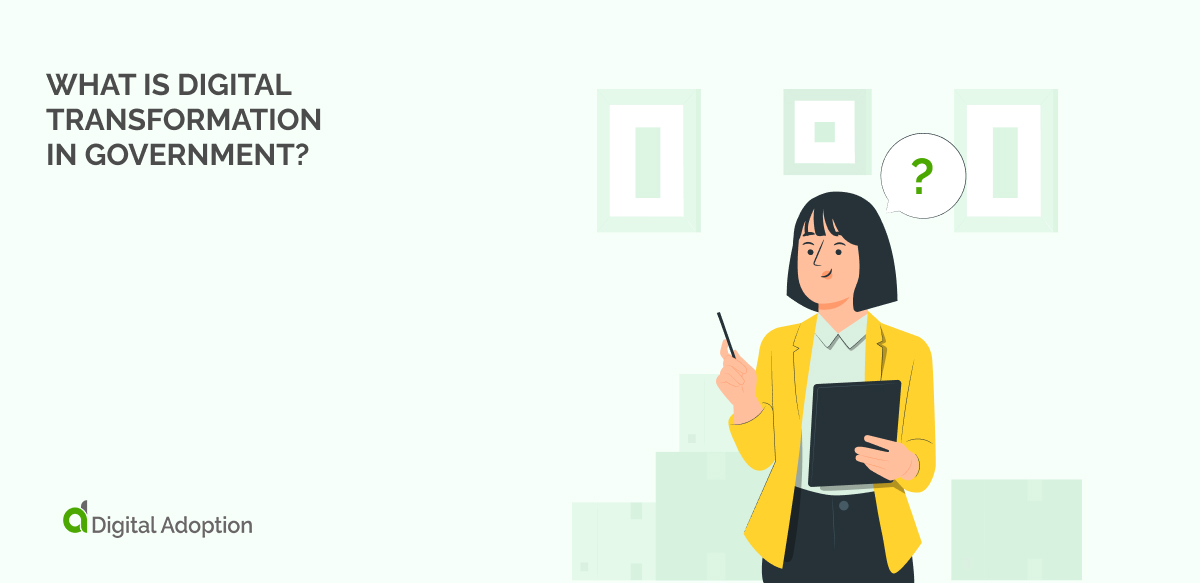
Digital transformation in government refers to the comprehensive integration and utilization of digital technologies, tools, and processes within public sector institutions. It encompasses the strategic implementation of modern solutions to improve operational efficiency, enhance service delivery, and foster a more transparent and accessible relationship between the government and its citizens.
In essence, digital transformation in government involves not only the transformation of new technologies but also a shift in organizational culture and mindset. This transformation requires governments to rethink traditional approaches and embrace innovative strategies that align with the digital era.
By doing so, public sector institutions can better address their constituents’ evolving needs and expectations, ultimately promoting a more inclusive, responsive, and efficient system of governance.
A McKinsey survey involving public-sector leaders found that almost 80% of major change initiatives did not achieve their objectives. A considerable 94% of respondents indicated that they faced at least one challenge associated with these endeavors. Moreover, less than a third were confident in handling these challenges effectively.
Essential drivers of government digital transformation
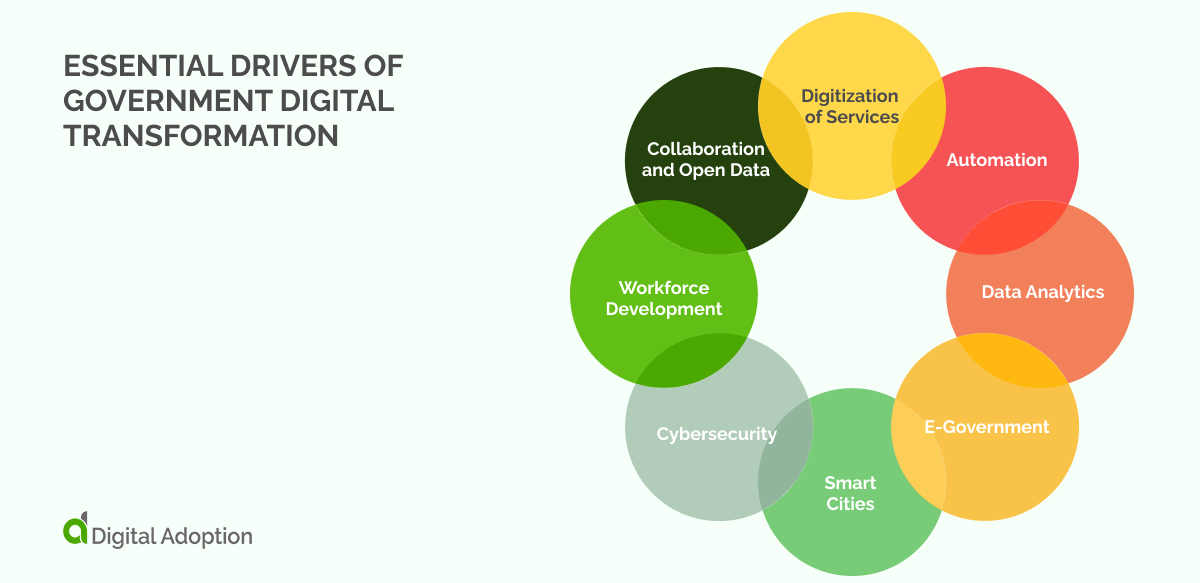
Government digital transformation is driven by several critical factors that enhance public services and modernize government operations. These key drivers include cybersecurity, automation, and smart cities.
Below, we’ve highlighted some key drivers propelling government digital transformation, ultimately leading to improved public services and more efficient government operations.
Digitization of Services: Converting paper-based processes, such as applications, permits, and record-keeping, into digital formats enables faster processing, easier access, and enhanced security.
Automation: Implementing technology solutions to automate repetitive tasks and processes can free up valuable human resources for higher-level tasks and decision-making.
Data Analytics: Utilizing data-driven insights to inform policy decisions, optimize resource allocation, and identify trends and patterns that can lead to improved public services.
E-Government: Offering online platforms and portals for citizens to access services, information, and communication channels with government agencies. This includes e-voting, e-taxation, and e-healthcare systems.
Smart Cities: Leveraging IoT (Internet of Things) devices, sensors, and advanced analytics to optimize urban infrastructure, public transportation, and other city services to enhance the quality of life for citizens.
Cybersecurity: Strengthening the protection of digital assets, networks, and systems against cyber threats and ensuring the privacy and security of citizen data.
Workforce Development: Upskilling and reskilling government employees to adapt to new technologies and digital workflows promotes a culture of continuous learning and innovation.
Collaboration and Open Data: Encouraging cross-agency collaboration, sharing of data, and open-source initiatives to foster innovation and drive better outcomes for citizens.
Benefits of digital transformation for government
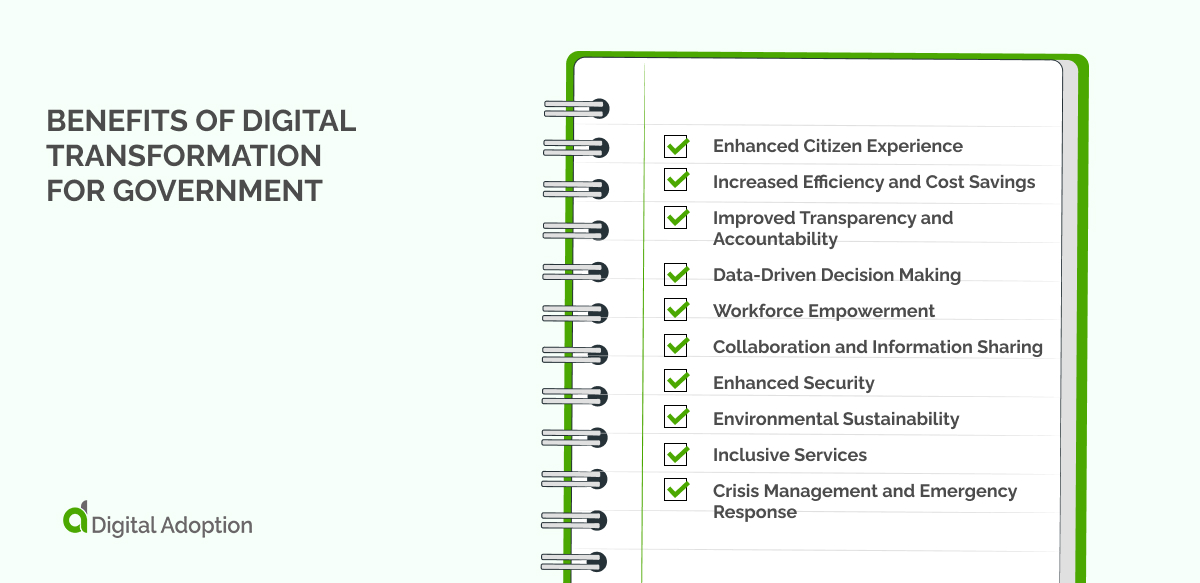
Digital transformation in the public sector offers numerous benefits that contribute to more efficient and effective government operations. Some of these benefits include:
Enhanced Citizen Experience: By leveraging digital technologies, governments can provide user-friendly, accessible, and tailored services that cater to citizens’ needs, ultimately improving their overall experience.
Increased Efficiency and Cost Savings: The transformation of digital tools and automation can streamline processes, reduce manual labor, and minimize operational costs, resulting in more efficient service delivery and resource allocation.
Improved Transparency and Accountability: Digital platforms enable governments to share information and data more openly, fostering greater transparency and trust between citizens and public institutions. Additionally, digital tools can facilitate performance measurement and accountability.
Data-Driven Decision Making: Utilizing data analytics and artificial intelligence, governments can make more informed policy decisions, optimize resource management, and identify trends that lead to improved public services.
Workforce Empowerment: Digital transformation allows for upskilling and reskilling of government employees, promoting a culture of continuous learning, innovation, and adaptability to new technologies and workflows.
Collaboration and Information Sharing: Digital tools facilitate seamless communication and collaboration between government agencies, breaking down silos and ensuring that vital information is shared effectively for better decision-making and service delivery.
Enhanced Security: By investing in advanced cybersecurity measures, governments can protect sensitive data and critical infrastructure from cyber threats, ensuring national security and citizens’ privacy.
Environmental Sustainability: The transformation of digital technologies can help governments reduce paper consumption, optimize energy usage, and implement environmentally friendly policies, contributing to a greener and more sustainable future.
Inclusive Services: Digital transformation enables governments to develop targeted, inclusive services that cater to the needs of vulnerable populations, such as persons with disabilities, older people, and those living in remote areas, ensuring equal access to essential public services. The government of New York City has introduced the NYC Open Data initiative, aiming to democratize knowledge by making open information accessible to all. This online platform allows the public to access and utilize data produced by various New York City agencies and other city-based organizations.
Crisis Management and Emergency Response: Digital technologies can significantly improve governments’ ability to respond to emergencies and natural disasters by providing real-time data, enhancing communication channels, and facilitating efficient resource allocation during times of crisis.
Obstacles in Digitalizing Government Services
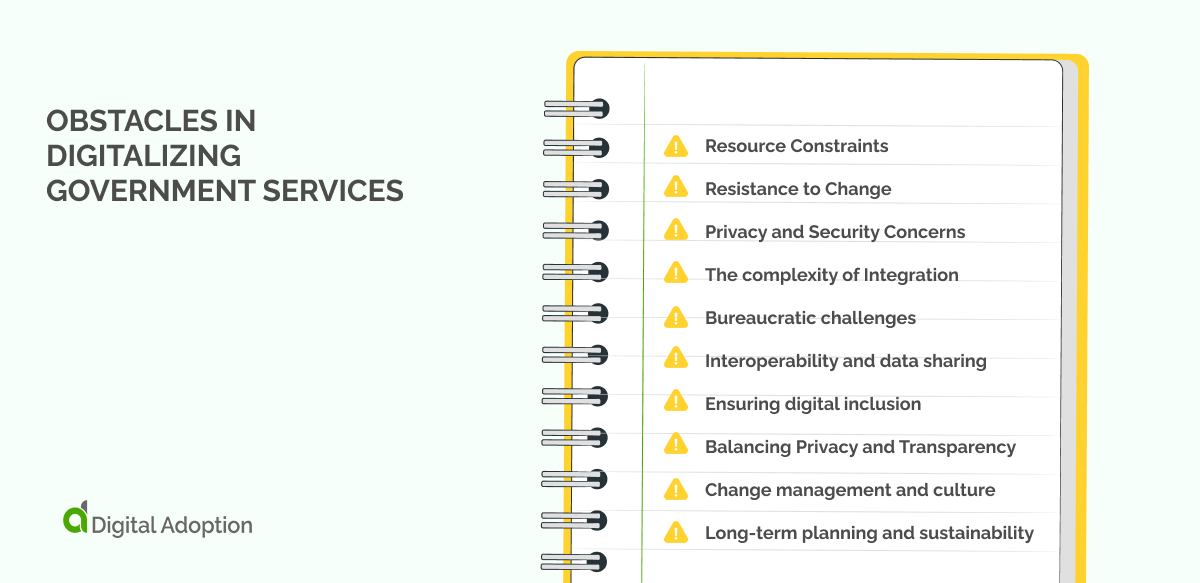
Despite the numerous benefits, governments undoubtedly face challenges when implementing digital transformation initiatives. Some of these obstacles include:
Resource Constraints: Budget limitations, lack of technical expertise, and inadequate infrastructure can hinder the successful implementation of digitalization efforts.
Resistance to Change: Organizational inertia and resistance from employees who are accustomed to traditional ways of working may impede the transformation of new technologies and practices. A review conducted by McKinsey, examining the tenure of health ministers in 23 countries between 1990 and 2009, discovered that 50% held their positions for less than two years. Such inconsistency in leadership can compromise the success of change initiatives, resulting in diminished trust and engagement among employees and the community.
Privacy and Security Concerns: Protecting sensitive citizen data and addressing cybersecurity threats are crucial digital transformation elements requiring significant attention and resources.
The complexity of Integration: Integrating digital tools and systems with existing processes and legacy systems can be complex and time-consuming, often requiring coordination across multiple government agencies.
Bureaucratic challenges
Government organizations’ bureaucratic nature can slow the transformation of new technology and processes. Governments must be willing to break down bureaucratic barriers and streamline decision-making processes to implement digital transformation initiatives successfully.
Interoperability and data sharing
Siloed government organizations often struggle to share data and collaborate effectively. This can lead to inefficiencies and missed opportunities for improving public services. To overcome this challenge, governments must prioritize interoperability and create a unified data-sharing framework that allows different agencies to communicate and collaborate seamlessly.
Ensuring digital inclusion
As governments increasingly rely on digital technologies to deliver public services, ensuring all citizens have access to these services is crucial. This means addressing the digital divide by investing in digital infrastructure, promoting digital literacy, and creating inclusive digital policies catering to vulnerable populations’ needs.
Balancing Privacy and Transparency
While digital transformation can increase government transparency and accountability, it can raise privacy and data protection concerns. Governments must strike a balance between making information accessible to citizens while also safeguarding their privacy rights. This involves implementing strict data protection regulations and ensuring that government employees are trained in responsible data handling practices.
Change management and culture
Digital transformation is about adopting new technologies and changing the mindset and culture within government organizations. Governments must invest in change management initiatives that promote a culture of innovation, collaboration, and adaptability. This includes providing training and support to government employees as they adapt to new working methods.
Long-term planning and sustainability
Governments need to adopt a long-term, strategic approach to reap the full benefits of digital transformation. This involves setting clear goals, allocating resources, and establishing performance metrics to track progress. It also requires a commitment to continuous improvement and adaptation as technologies and citizen needs evolve over time.
Real-life Cases of Digital transformation in Governments
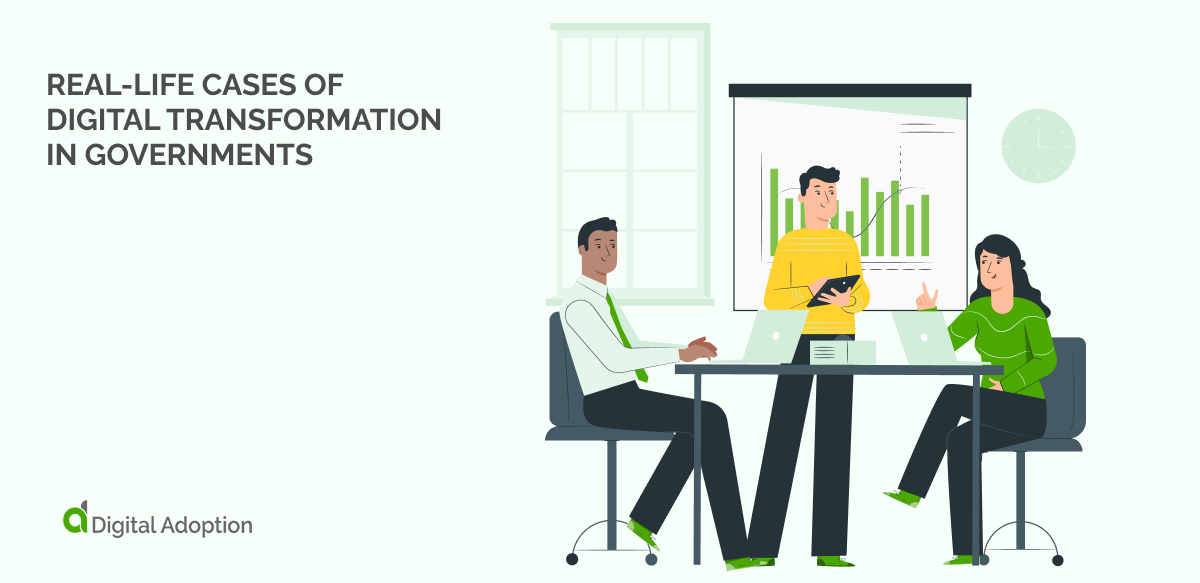
Governments worldwide are increasingly embracing digital transformation to streamline operations, enhance efficiency, and improve citizen services. By leveraging cutting-edge technologies, public sector entities can transform how they function and interact with their constituents.
Here are some real-life examples of digital transformation in governments:
Estonia’s e-Government Initiatives: Estonia is a global leader in digital governance, offering more than 99% of its public services online. Its e-government solutions include electronic ID cards, digital signatures, and e-voting systems. These initiatives have significantly reduced bureaucracy, increased transparency, and improved the ease of doing business in the country.
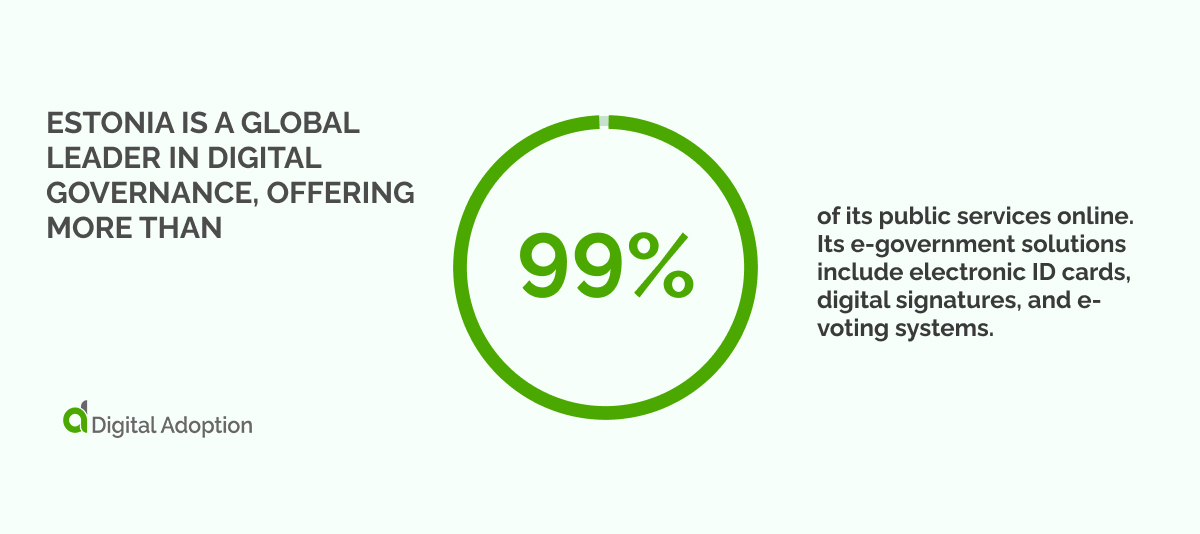
India’s Aadhaar Program: India has implemented the world’s largest biometric identification system, Aadhaar, which assigns a unique 12-digit number to each citizen based on their biometric data (fingerprints and iris scans). This initiative has streamlined social welfare programs, reduced corruption, and made it easier for citizens to access essential services such as banking and healthcare.
Singapore’s Smart Nation Vision: Singapore is actively pursuing its Smart Nation vision by integrating advanced technologies into various aspects of governance. The city-state has introduced initiatives such as the National Digital Identity (NDI) system, e-payments infrastructure, and intelligent transport systems to enhance the quality of life for its citizens and boost economic competitiveness.
United States 18F and USDS: The United States has established two digital service teams, 18F and the United States Digital Service (USDS), to help federal agencies adopt modern technologies and improve service delivery. These teams work on projects ranging from revamping government websites to streamlining procurement processes, making it easier for citizens to interact with government agencies and access information.
United Kingdom’s Government Digital Service (GDS): The UK’s GDS was created to lead the digital transformation of government services. It has developed the GOV.UK platform is a single access point for all government services and information, simplifying the user experience (UX) and providing a consistent interface for citizens. GDS also assists other government departments in adopting digital best practices, ensuring that services are designed with user needs in mind.
These real-life examples demonstrate the transformative potential of digital transformation in governments. By embracing technology and innovation, public sector entities can enhance service delivery, increase transparency, and improve their citizens’ overall quality of life.
Paving the way for government digital excellence in 2023
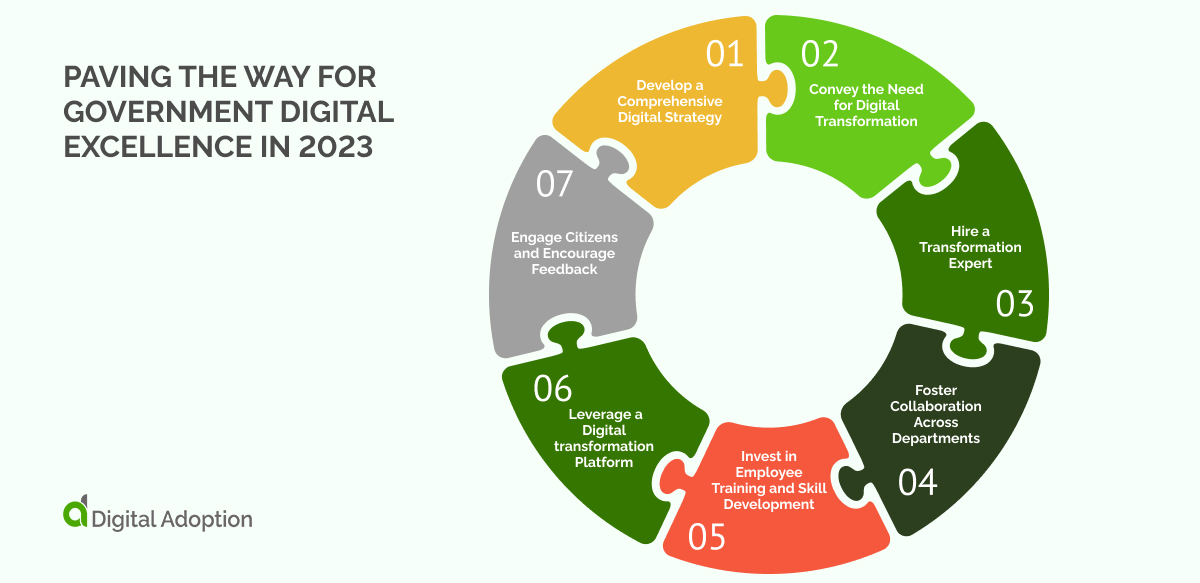
As we venture into 2023, it is crucial for governments across the globe to continuously evolve and adapt in order to effectively tackle an array of complex challenges at both macro and micro levels, encompassing national and local issues.
Here are seven methods to ensure the success of government digitalization initiatives:
- Develop a Comprehensive Digital Strategy: A well-defined digital strategy is essential for aligning all stakeholders, setting clear objectives, and establishing milestones. Governments should create a roadmap that outlines their digital transformation goals, identifies key performance indicators, and addresses potential challenges.
- Convey the Need for Digital Transformation: Articulating the necessity and benefits of digital transformation is crucial for gaining buy-in from stakeholders and employees. Governments should communicate the long-term vision, outline the potential positive impacts on public services, and emphasize the importance of keeping pace with technological advancements.
- Hire a Transformation Expert: Engaging an experienced digital transformation leader can help guide and oversee the entire process. This individual should possess a strong understanding of technology and public sector dynamics, enabling them to identify opportunities, mitigate risks, and drive the successful implementation of digital initiatives.
- Foster Collaboration Across Departments: Encouraging cross-departmental collaboration is crucial for breaking down silos and ensuring seamless information flow. Governments should create an environment where departments share best practices, pool resources, and collaborate to drive digitalization initiatives.
- Invest in Employee Training and Skill Development: As technology evolves, so must the skillsets of government employees. Investing in continuous training and development programs will ensure that staff members can effectively utilize new digital tools and contribute to the success of digitalization efforts.
- Leverage a Digital transformation Platform (DAP): DAPs are pivotal in accelerating digital transformation by guiding users through new software and processes. Governments can use DAPs to streamline employee onboarding, enhance user experience, and increase overall transformation rates for digital tools. By offering personalized support and real-time assistance, DAPs help users overcome challenges and maximize the benefits of digital solutions.
Governments can use DAPs, such as WalkMe’s platform, to streamline employee onboarding, enhance user experience, and increase overall transformation rates for digital tools. By offering personalized support and real-time assistance, DAPs help users overcome challenges and maximize the benefits of digital solutions.
- Engage Citizens and Encourage Feedback: Successful digitalization efforts must prioritize the needs and expectations of citizens. Governments should actively engage with the public, gathering feedback and insights to inform their digital initiatives. Transparent communication and regular updates can help build trust and encourage citizen participation, leading to more effective digital services.
As we navigate the complexities of the digital age, governments need to embrace and harness technological advancements to serve their citizens better. According to Statista, digital transformation (DX) expenditures amounted to 1.6 trillion USD in 2022. Global digital transformation spending is forecast to reach 3.4 trillion USD by 2026.
By fostering a culture of innovation and collaboration, governments can overcome challenges and drive meaningful change in the public sector. This transformation guide outlines key strategies for successful government digital transformation, including stakeholder engagement, streamlined processes, necessary infrastructure, and continuous learning.
Governments can create a more inclusive, efficient, and transparent operation by implementing these strategies to bridge the digital divide and ensure equitable access to services for all citizens.

